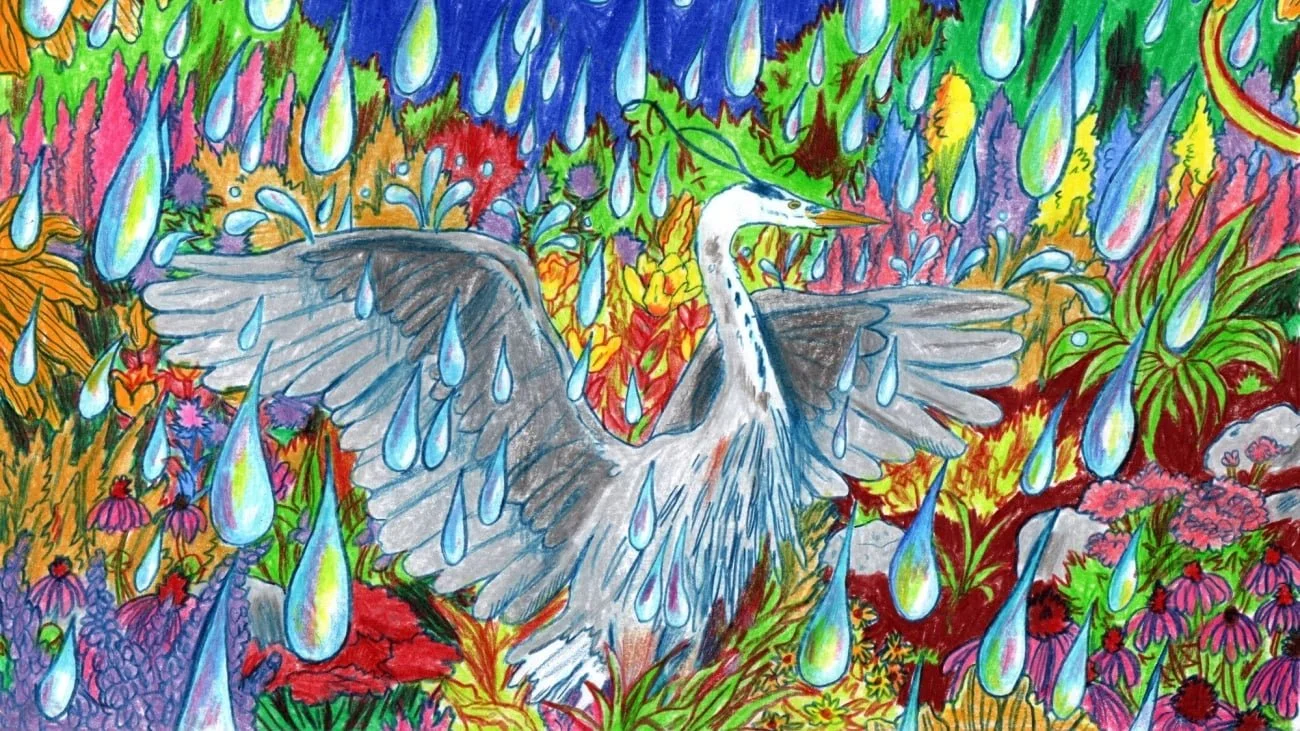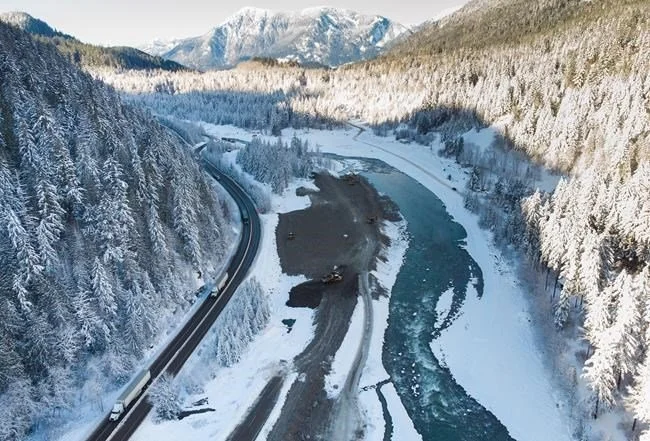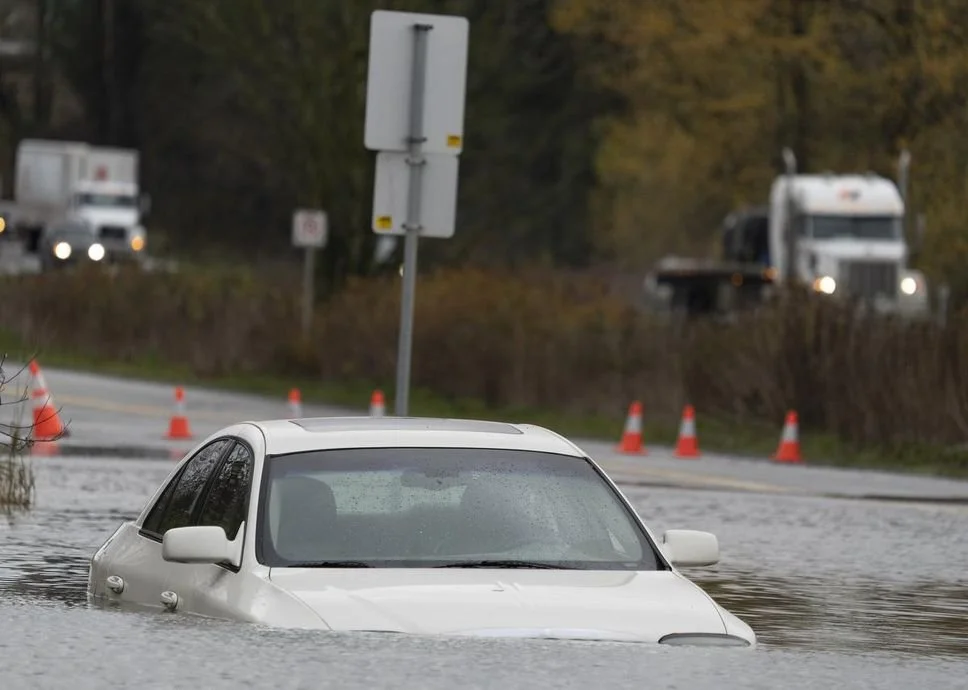Two years ago, what would soon become a historic atmospheric river made landfall in B.C. as nearly a month's worth of rain pounded down on the province in less than 48 hours. Over a terrifying few days, mass evacuations were ordered, thousands of animals were lost, and homes were flooded to their upper levels. Every highway connecting the Lower Mainland to the rest of the province was badly damaged or destroyed.
Fall's cold arrival hasn't shaken off the impact of B.C.'s months-long drought
Climate geoscientist Joseph Shea didn't have to go far to find evidence of what he calls "exceptional'' hot and dry weather in British Columbia this year. He says he was still gathering raspberries in his garden in Prince George, B.C., last week as temperatures neared 20 C, at a time when the historical average maximum is about 9 C.
California lifts some water restrictions after storms and floods
California's stormy winter, which has brought severe flooding and landslides to the state, has led some local officials to lift water rules. Water conservation restrictions have been relaxed for nearly seven million people in Southern California after the state's 11th atmospheric river this season helped ease drought. But experts cautioned drought remains a long-term concern for the state. "Dry conditions could return as soon as next year," local officials said.
When it comes to heavier storms, rain gardens can help
At the most basic level, rain gardens function like sponges. They are typically made by digging five or so feet into the ground, adding layers of rock and soil mixes designed to absorb and filter water, and topping the layers with flowers, trees, and shrubs. A finished rain garden should dip like a bowl about half a foot below ground level so that when it rains, the garden can temporarily fill up, allowing water to percolate into the ground rather than run into the street.
1 year later, British Columbians who lost everything reflect on devastating floods
John Jongema's house is habitable again, but he is not getting rid of the fifth-wheel trailer he moved onto his farmland to ride out the rebuild anytime soon. "I'm keeping that trailer as a getaway," he said with a nervous chuckle. Jongema, who lives on a hobby farm on the Sumas Prairie about 90 kilometres east of Vancouver, is one of nearly 20,000 people in the southern part of British Columbia forced from their homes a year ago after record-breaking rains caused catastrophic flooding. The relentless rain came via an atmospheric river — an airborne stream of water vapour across the Pacific that originated in the subtropics. It triggered fatal mudslides, damaged critical highway infrastructure and called into question responsibility for flood mitigation in a province repeatedly pummeled by the impacts of climate change.
B.C. flood recovery tempered by fears of new climate disasters looming on horizon
When a dike was breached and floodwaters started to flow across British Columbia’s Sumas Prairie a year ago, poultry farmer Corry Spitters said all he could do was let nature take its course. A feeling of helplessness gripped him as the encroaching water methodically engulfed his farm’s 21 barns, and 200,000 of his chickens drowned, he said. “You stand there and Mother Nature takes control,” said Spitters, 67. “What can you do? The water comes in and there’s nothing you can do.”
Next atmospheric river on its way to B.C., bringing heavy rain and hope to drought-stricken areas
The next atmospheric river of the season is forecast to bring heavy rain to coastal British Columbia by late Thursday and this one could drench drought-stricken areas that have been bypassed by recent storms. Rain is predicted to be heaviest on the west coast of Vancouver Island, where about 80 millimetres could fall in less than 36 hours, while Environment Canada models show some Metro Vancouver communities could receive 60 millimetres or more.
Heavy rain boosts water levels for salmon seeking to spawn
Mother Nature is about to throw another wet and windy punch our way this weekend, with “continuous and significant rainfall” and strong winds forecast from Victoria to Port Hardy starting Saturday morning or afternoon, depending on where you live. Rainfall, which is expected to last until Monday in some areas, will be heavier than the season’s initial atmospheric river on Thursday that knocked out power to more than 18,000 homes and caused dangerous driving conditions.
David Suzuki: Water runs through the climate crisis
Sometimes there’s too much water; sometimes not enough. A major challenge with global heating is that it doesn’t necessarily cause more or less of something in a specific geographic area (hotter, colder; wetter, dryer); it just makes everything less predictable and often more extreme. Consider some late-summer headlines. Pakistan “faces ‘monsoon on steroids’ as more flood warnings issued”. In Spain, “Historic monuments resurface as severe drought shrinks reservoirs.” Melting Greenland ice is “set to raise sea levels by nearly a foot”. In Jackson, Also, in the U.S., “As Colorado River dries, the U.S. teeters on the brink of larger water crisis”.Mississippi, the “water system is failing, city will be with no or little drinking water indefinitely”.
Environment Canada links B.C. floods to human-induced climate change
Human-induced climate change “contributed substantially” to the atmospheric river and ensuing floods that devastated B.C. last year, a new study by Environment Canada scientists confirms, warning Canadians to brace for more of the same. “The chance this kind of flood will happen has increased by 100 to 300 per cent due to human influence,” Xuebin Zhang, a senior research scientist with Environment and Climate Change Canada, told Canada’s National Observer.
Study suggests climate change made B.C. floods at least twice as likely
Catastrophic floods that swamped much of southern British Columbia last fall were at least twice as likely because of climate change, suggests new research from Environment Canada. The study, now undergoing peer review, concludes that the likelihood of similar events in the future will only increase as global warming continues to upend normal weather patterns. "We do find substantial ongoing increases in the probability of these kinds of events," said Nathan Gillett, an atmospheric physicist and manager of the Canadian Centre for Climate Modelling and Analysis.
B.C.'s South Coast bracing for atmospheric river with up to 100 mm of rain possible
Environment Canada has issued another weather warning for the South Coast of British Columbia. An atmospheric river event is expected to melt weeks' worth of snow at a rapid rate which could trigger localized flooding. However, weeks worth of built up snow and ice is expected to melt aggressively which could cause washouts near rivers, creeks and culverts. “The rainfall itself you know this would probably show up as being a fairly run-of-the-mill moderate storm event that we’ve seen a half dozen times or more this season,” said Dave Campbell, of the River Forecast Centre. Heavy downpours can cause flash floods and water pooling on roads, so drivers are being urged to slow down and drive for the conditions.
IN PHOTOS: 12 notable Canadian stories in 2021
On Oct. 12, due to concerns about fuel contamination, Iqaluit issued a do-not-consume order for its tap water that lasted nearly two months. The city of 8,000 would eventually point to an underground fuel spill as the potential cause of the contamination. After learning that the city's water was not safe to drink, residents in Iqaluit collected water from the nearby Sylvia Grinnell River. The military was dispatched to help provide treated water from the river using mobile water treatment units.
B.C. flood update: Rain warning still in effect | Abbotsford now in two-front flood fight | More evacuation alerts and orders
Between 60 and 90 millimetres of rain is forecast for most regions, except up to 120 millimetres over the northern sections of Metro Vancouver, including the North Shore mountains and Pitt Meadows. Squamish could see up to 150 millimetres, according to the rainfall warning posted Wednesday morning. The agency warns elevated freezing levels and snowmelt may contribute to increased runoff. The rain is expected to taper off tonight.
Atmospheric river ranking system still years away
Liberal MLA for Abbotsford calls on province to help farmers restore properties, businesses
The Liberal MLA for Abbotsford South says the provincial government should be responsible for helping farmers in flood-stricken communities get back on their feet. Bruce Banman says the province failed to notify its residents, especially in floodplain areas like the Sumas Prairie, when an atmospheric river brought more than 200 millimetres of rain earlier this month. "This government was not paying attention to the Nooksack River at all and we lost 48 precious hours to be able to move equipment," Banman said on the CBC's The Early Edition.
Before-and-after photos from the Sumas Prairie region of Abbotsford show the area's slow recovery
Some areas of the Sumas Prairie are showing signs of recovery, even as the region prepares for another series of storms, with one atmospheric river arriving on Saturday and another larger one on Tuesday. - Ben Nelms, Staff Photographer Ben Nelms is an award-winning photojournalist based in Vancouver, B.C.
What’s an atmospheric river? Here’s why B.C. is seeing floods, mudslides
The torrential rainfall that has pummeled British Columbia in recent days — causing mudslides and flooding, shutting down highways and stranding and displacing thousands — is being fuelled by an atmospheric river. Atmospheric rivers are long, narrow bands of moisture in the atmosphere that carry water from the tropics and subtropics toward the poles.
‘Atmospheric river’ rainstorm headed for Fraser Valley, up to 70 mm expected
A heavy rainstorm is expected to hit the Fraser Valley, bringing 50 to 70 millimetres of rain, according to a warning from Environment Canada. Meteorologists call this type of rain pattern an “atmospheric river.” It’s caused by narrow regions in the atmosphere transporting water vapor outside the tropics. Once the vapor hits land, it releases in the form of rain or snow.
Jack Knox: Rain, rain go away (though the water can stay)
Thirty years ago, a public backlash over the issuance of a half-dozen water-shipping permits spurred B.C. to put a moratorium on bulk water exports, a measure later backed up with legislation. Santa Barbara-based Sun Belt Water, which had a deal with Snowcap Waters of Fanny Bay to ship supertankers of water to California, announced it would challenge that decision under NAFTA, but then the story petered out.





















